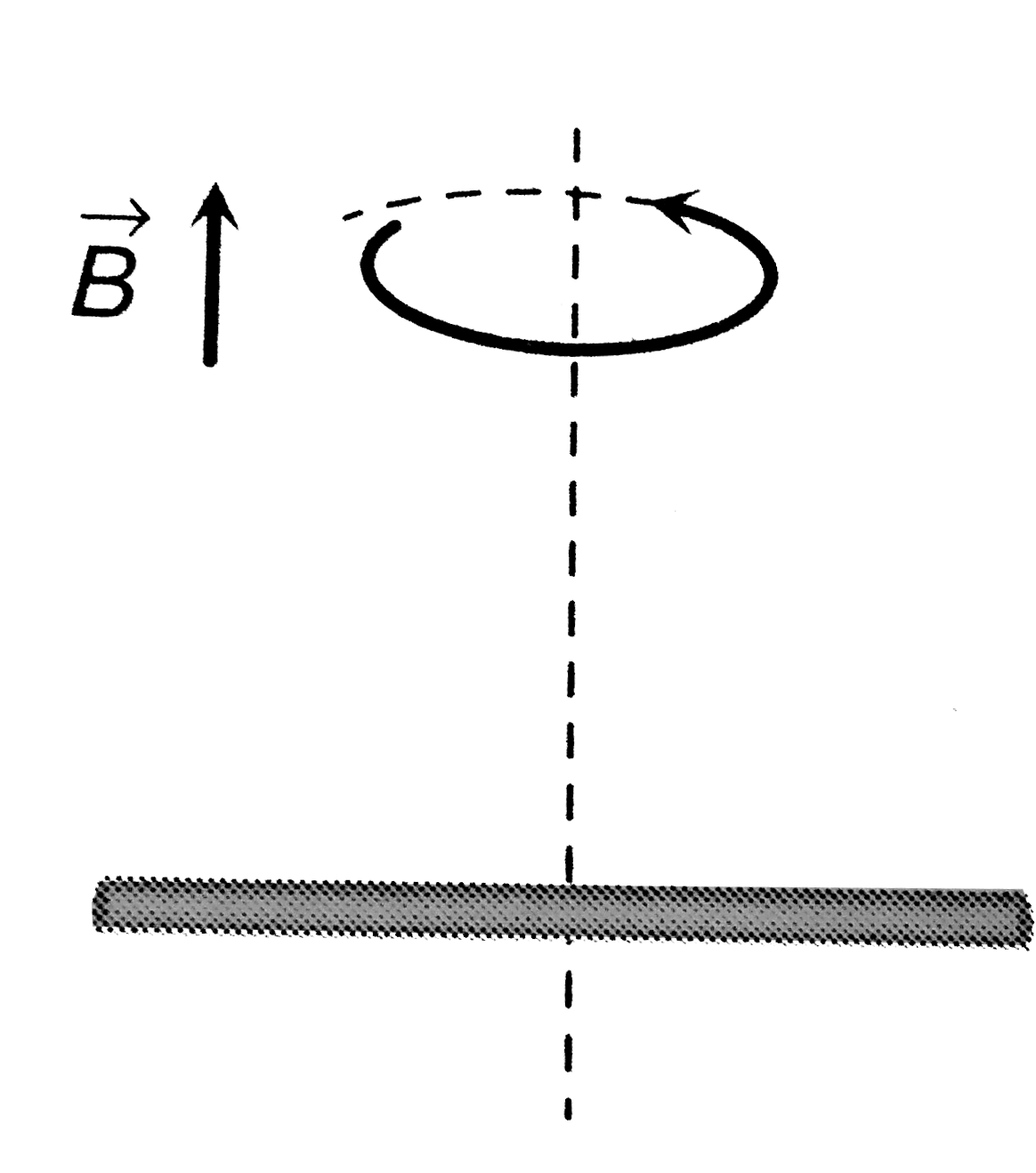A metal rod length l rotates about on end with a uniform angular velocity ω. A uniform magnetic field →B exists in the direction of the axis of rotation. Calculate the emf induced between the ends of the rod. Neglect the centripetal force acting on the free electrons as they moving in circular paths.
To solve the problem of calculating the induced EMF between the ends of a rotating metal rod in a magnetic field, we can follow these steps:
1. Understand the Setup:
- We have a metal rod of length L that is rotating about one end (let's call it point A) with a uniform angular velocity ω.
- A uniform magnetic field →B is directed along the axis of rotation.
2. Identify the Velocity of a Point on the Rod:
- Consider an infinitesimal section of the rod at a distance x from point A. The linear velocity vx of this section due to rotation is given by:
vx=ωx
3. Calculate the Induced EMF in an Infinitesimal Section:
- The induced EMF dE in the infinitesimal section dx of the rod can be expressed using the formula:
dE=vxBdx
- Substituting for vx:
dE=(ωx)Bdx=ωBxdx
4. Integrate to Find Total EMF:
- To find the total EMF E induced along the entire length of the rod from point A (0) to point B (L), we need to integrate dE:
E=∫L0dE=∫L0ωBxdx
- The integral can be computed as follows:
E=ωB∫L0xdx=ωB(x22)L0=ωB(L22−0)=ωBL22
5. Final Result:
- Thus, the induced EMF between the ends of the rod is:
E=ωBL22
- We have a metal rod of length L that is rotating about one end (let's call it point A) with a uniform angular velocity ω.
- A uniform magnetic field →B is directed along the axis of rotation.
- Consider an infinitesimal section of the rod at a distance x from point A. The linear velocity vx of this section due to rotation is given by:
vx=ωx
- The induced EMF dE in the infinitesimal section dx of the rod can be expressed using the formula:
dE=vxBdx
- Substituting for vx:
dE=(ωx)Bdx=ωBxdx
- To find the total EMF E induced along the entire length of the rod from point A (0) to point B (L), we need to integrate dE:
E=∫L0dE=∫L0ωBxdx
- The integral can be computed as follows:
E=ωB∫L0xdx=ωB(x22)L0=ωB(L22−0)=ωBL22
- Thus, the induced EMF between the ends of the rod is:
E=ωBL22
Topper's Solved these Questions
- BOOK - HC VERMA ENGLISHCHAPTER - ELECTROMAGNETIC INDUCTIONEXERCISE - Objective 111videos
ELECTROMAGNETIC INDUCTION
- BOOK - HC VERMA ENGLISHCHAPTER - ELECTROMAGNETIC INDUCTIONEXERCISE - Objective 210videos
ELECTROMAGNETIC INDUCTION
- BOOK - HC VERMA ENGLISHCHAPTER - ELECTROMAGNETIC INDUCTIONEXERCISE - Questions for short answer9videos
ELECTROMAGNETIC INDUCTION
- BOOK - HC VERMA ENGLISHCHAPTER - ELECTRIC FIELD AND POTENTIALEXERCISE - Objective 27videos
ELECTRIC FIELD AND POTENTIAL
- BOOK - HC VERMA ENGLISHCHAPTER - ELECTROMAGNETIC WAVESEXERCISE - Exercise8videos
ELECTROMAGNETIC WAVES
Similar Questions
A metal rod of length 15×10−2m rotates about an axis passing through one end with a uniform angular velocity of 60 rad s−1. A uniform magnetic field of 0.1 Tesla exisits in the direction of the axis of rotationn. Calculate the EMF induced between the ends of the rod.
View SolutionA conducting rod OA of length l is rotated about its end O with an angular velocity ω in a uniform magnetic field directed perpendicualr to the rotation. Find the emf induced in the rod, between it's ends.
View Solution
Knowledge Check
- Question 1 - Select One
A rod of length l rotates with a uniform angular velocity omega about its perpendicular bisector. A uniform magnetic field B exists parallel to the axis of rotation. The potential difference between the two ends of the lrod is
ABl2ω2BzeroC(Bl2ω8)D2Bl2ω
A rod of length l rotates with a uniform angular velocity omega about its perpendicular bisector. A uniform magnetic field B exists parallel to the axis of rotation. The potential difference between the two ends of the lrod is
View SolutionA conducting rod of length 2l is rotating with constant angular speed w about its perpendicular bisector. A uniform magnetic field B exists parallel to the axis of rotation. The e.m.f. induced between two ends of the rod is
 View Solution
View SolutionA conducting rod of length 2l is rotating with constant angular speed w about its perpendicular bisector. A uniform magnetic field B exists parallel to the axis of rotation. The e.m.f. induced between two ends of the rod is
 View Solution
View SolutionA rod of length l rotates with a small but uniform angular velocity ω about its perpendicular bisector. A uniform magnetic field B exists parallel to the axis of rotation. The potential difference between the centre of the rod and an end is
View SolutionA wire loop confined in a plane is rotated in its open plane with some angular velocity. A uniform magnetic field exists in the region. Find the emf induced in the loop.
View SolutionA conducting disc of radius r rotaes with a small but constant angular velocity ω about its axis. A uniform magnetic field B exists parallel to the axis of rotation. Find the motional emf between the centre and the periphery of the disc.
View SolutionA conducting rod of length l is rotating with constant angular velocity ω about point O in a uniform magnetic field B as shown in the figure . What is the emf induced between ends P and Q ?
 View Solution
View Solution

